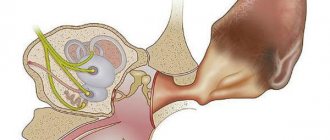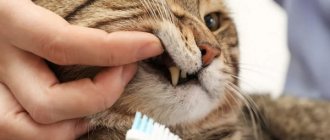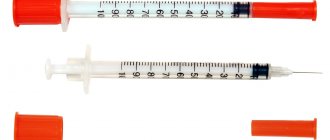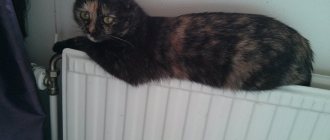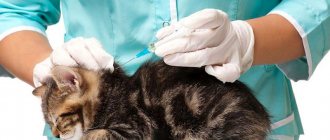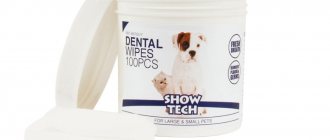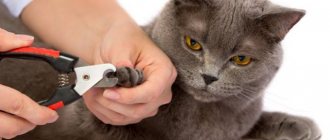Why does dirt appear in a cat's ears?
If your cat is healthy, earwax will have a yellowish or slightly brown tint. Very little of it is released to protect against the penetration of fungi, bacteria and insects.
The process of sulfur formation is individual and depends on many factors: living conditions, nutrition, breed. Some representatives of the cat's ears get dirty often, while others require cleaning once every six months.
A healthy cat's ear should not become dirty quickly. If after cleaning, after 3-4 days, plaque forms, there is discharge, and an unpleasant odor is a reason to consult a veterinarian.
If dark, black plaque or dirt is detected, action must be taken - this is the first sign of otodectosis - ear mites. In this case, the plaque may be in the form of flakes or similar to ground coffee. The presence of liquid discharge of any color in the ear canal indicates the onset of otitis media.
The most common ear problems
A visual examination of the ears of cats can detect several diseases. The symptoms they experience are different.
Ear mite
The most common disease in cats is otodecosis (ear scabies), which is caused by ear mites. This parasite lives in the ear canal and feeds on epithelial cells. It is impossible to see it with the naked eye due to its microscopic size, but traces of its vital activity are clearly visible.
Ear mites cannot be seen with the naked eye.
The symptoms of the disease are as follows:
- the cat behaves restlessly, often shakes its head and rubs it against the furniture;
- furiously scratches his ears with his hind paws, sometimes scratching them until they bleed;
- ears smell unpleasant;
- Inside the ear you can see dark brown crumbly plaque and crusts.
In advanced cases of otodecosis, hearing may deteriorate.
Cats are most often affected by ear mites.
For advice, please contact a veterinary clinic. The specialist will prescribe the necessary medication to treat this disease. Be sure to thoroughly wash your cat’s ears every day, using specialized care products (Leopard, etc.). The solution may sting the skin slightly, so you will need to hold your pet tightly, wrapped in a cloth. After cleaning, drops prescribed by the veterinarian are placed as deep as possible into the passage. To prevent the cat from shaking its head after this, you need to press its ears and hold it there for several minutes. Otherwise, the animal will simply shake the medicine out.
When infected with ear mites, it is recommended to use specialized preparations
From personal experience. We picked up the previous cat on the street in an extremely dirty and neglected condition. When they washed it and dried it, it turned out that the ears were full of dark plaque. Although he was not wild, he endured the washing procedure with great difficulty. We fought the tick for a very long time, the degree of damage was high. At the same time, the cat constantly jerked and shook its head, sometimes hitting it on the floor and furniture. He scratched the skin in his ears until he bled. Then throughout my life I had to periodically instill medicinal drugs. If you forget a little, the tick will immediately show up again.
Otitis
Inflammation of the external auditory canal caused by bacteria or yeast is called otitis media.
The disease is expressed by the following symptoms:
- purulent discharge with an unpleasant odor comes out of the ear;
- the animal is worried and periodically shakes its head;
- redness and swelling are observed on the ear mucosa;
- the cat presses and scratches his ears, while meowing very pitifully (it is clear that he is in pain).
With otitis media, the cat behaves restlessly
If you have these symptoms, you should immediately contact a veterinary clinic to receive qualified treatment.
With otitis externa, pus is discharged from the ear
Self-medication for any form of otitis in a cat is strictly contraindicated. The inflammatory process can spread to the inner ear, and from there to the meninges. This is extremely dangerous.
Ear hematomas
If a cat shakes its head too intensely or scratches its ears violently, blood vessels burst and bruises form. They appear as multiple small brown spots of coagulated blood between the shell cartilage and the skin. This behavior may be the result of flea or ear mite infestation, and may also be caused by an infection (otitis media) or allergies.
A hematoma in a cat’s ear does not require special treatment.
No special treatment for hematoma is required; it is necessary to deal with the underlying problem.
Solar dermatitis
Cats that lack melanin (albinos), hairless animals, and those with white ears are susceptible to sunburn. The auricle first turns red, then hair falls out along the edge, the skin thickens and itches very much. Due to multiple scratches, there is a risk of infection with infectious diseases. Untreated dermatitis can lead to the development of cancer.
White cats are more susceptible to solar dermatitis
Squamous cell carcinoma
Malignant skin tumors (carcinoma) are sometimes found in cats. This type of growth is usually the result of exposure to excess sunlight. It can affect various areas of the skin, but most often appears on the ears. It manifests itself in the form of long-lasting red spots, seals, hair loss and slow-healing ulcers.
Squamous cell carcinoma is sometimes found in white cats
Frostbite
Exposure to extreme cold destroys ear tissue. First, the skin becomes discolored, then turns red, and later turns black and peels.
From personal experience. When we bought our house, we inherited a tabby cat. Despite frosts of -40°C, he constantly walked outside. He only came home to eat. The cat had almost no ears, only small stumps remained in place of the ears. His previous owner was an old woman and did not treat her pet at all. The wounds simply became painful and healed.
Extreme cold can damage your ears
If you have any suspicious symptoms, you should consult a veterinarian. Only he will be able to prescribe competent treatment and help avoid serious consequences for the pet’s health.
Cleaning Frequency
Healthy cats' ears clean themselves. Sulfur is released to the surface when chewing. Plus, the animal itself removes its excess with its paw while washing, shaking its head. But some cats have a lot of discharge, and the owner must help the pet.
To understand when it's time to clean your cat's ears, you need to conduct periodic inspections. It is better to do this in good lighting. This makes it easier to determine the type of plaque and the condition of the auricle. Animals walking on the street are examined daily in order to promptly detect the presence of a foreign body.
On average, a cat needs ear cleaning 1-2 times a month, for some cats no more than 2 times a year. Therefore, how often to carry out a hygiene procedure is determined strictly individually and according to the degree of contamination. Too frequent cleaning is unsafe, since along with the sulfur its protective properties disappear.
Caring for show cats is more thorough. Cleansing is carried out on a regular basis. It is impossible to win with dirty ears.
Cats with floppy ears and no hair need ear cleaning more often. It is believed that the shell of fold-eared cats, due to its structure, does not clean itself, and the animals are more often susceptible to ear diseases.
A little about the structure of a cat's ear
The cat's ear, like the human ear, consists of three sections:
- Outer ear. The outer ear contains the auricle, which the owner will have to inspect for dirt, and the external auditory canal;
- Middle ear. Its “package” includes the eardrum and auditory ossicles, which play one of the main roles in the perception of sound;
- Inner ear. The inner ear contains the vestibular apparatus, which allows the cat to calculate its movements, as well as the structures of the nervous system responsible for recognizing stimuli coming from the environment and from the body itself.
Structure of a cat's ear
A cat's ears are often likened to antennas or radars, which perfectly reflects their functionality. Our pets are able to detect even ultrasonic frequencies that are completely inaccessible to human ears. In addition, the special structure of cat ears allows these animals to determine the source of sound with centimeter accuracy, which is very useful during the hunt. It is this feature that allows cats to capture prey in one jump.
Cats' ears are much more mobile than human ears, which allows them to pick up sound faster.
The similarity with an antenna is also explained by the cat’s ability to turn its ears depending on the sound source at an angle of up to 180 degrees. Due to the fact that the ears can be turned asymmetrically and move in different directions, the cat achieves even greater fullness of sound. In order to control the ears, the cat's body has more than 30 muscles.
How to properly clean a cat's ears
Technique on how to clean a cat’s ears at home for the purpose of prevention:
- Place the cat on your lap. If it resists, fix it with a towel, leaving only the head free. It is important to calm the cat down and speak to him in a gentle voice.
- Carefully unfold the auricle. This will not cause the cat any discomfort and will not hurt him.
- It is difficult to remove completely dry dirt. To treat the auricle and canal, use a special spray that softens the wax. You need to choose a neutral lotion that does not contain medicinal substances. You can clean it with Vaseline or olive oil, saline solution. The most budget option is warm boiled water. Often water cannot be used, because... The skin may deteriorate.
- Moisten a cotton pad (preferably without stitched edges) and gently insert it into your ear with your finger.
- Pass the disc without pressing along the inside of the ear. A separate disc is used for each ear to avoid accidentally spreading infection.
- If the surface is wet, wipe with a dry swab or towel.
There are hard-to-reach places in the ear - folds, from where wax and dirt are removed with a cotton swab, also soaked in the solution.
However, veterinarians do not recommend cleaning the ear canal with a cotton swab at home. The ear canal of cats is curved. There is a great risk of pushing the contents deep into the canal and damaging the eardrum. If you decide to use cotton swabs, you must act carefully. All movements should be directed outward.
Do cat ears need care?
As already mentioned, cat ears can remain untidy for a long time even with the most caring owner. It is this body that has received the least attention, and absolutely unjustifiably. The fact is that cats, being very clean animals by nature, do not have the ability to care for their ears on their own and need outside help.
If left uncared for, ear plugs form in a cat's ears, leading to hearing loss.
The accumulation of wax in the ear canals is common to both humans and cats. And if the owner cleans his ears a couple of times a week, then he should think about the cat whose ears have hardly ever been cleaned. Of course, cats can live their entire lives with their ears gradually becoming dirty, and not show signs of dissatisfaction (besides, cats are very stingy in expressing their physical discomfort).
Cats can go for years without having their ears cleaned, which will, however, be harmful to their health.
However, it doesn’t happen once at a time - a lot depends on the very shape of the cat’s ear - some ears are less prone to inflammation and plugs, some more so. If you do not want to one day encounter ear disease in your pet, we advise you to pay attention to the rules of hygiene and start following them as soon as possible.
Cleansing when heavily soiled
If upon inspection a large accumulation of sulfur is detected, rinsing is carried out using drops and sprays. The product penetrates well into the ear canal and softens wax plugs. You can safely instill 5-10 drops and massage the base of the ear well.
It is better not to let the pet out for 2-3 minutes so that the liquid is accurately distributed throughout the ear canal. Then you can let the cat shake it out along with the softened deposits. After this, just wipe the inner surface of the sink with a cotton pad soaked in the same product.
You need to rinse until your ears are completely clean.
Features of cleaning a kitten's ears
Many veterinarians claim that a kitten's ears are too tender for massive cotton swabs and swabs. However, it is still necessary to clean your pet’s miniature ears of accumulated secretions and dirt. For this procedure, they usually use a saline solution in a bottle, which is smoothly poured into the pet’s ears. First, three to five drops are instilled on the inner surface of the ear, after which another six to seven drops are instilled into the ear canal.
Cleaning your kitten's ears should not involve the use of harsh materials.
After instillation, the kitten’s ears are massaged for a couple of minutes to improve fluid passage. It is necessary to massage the ears at the base - this will distribute the saline solution more evenly. At the end of the procedure, put the kitten down and let him shake out the wax and secretions that have come out of his ears thanks to the drug. After this, wipe the kitten's ears with a towel to get rid of any remaining liquid.
Video: Cleaning a kitten's ears
How to clean your ears
Various products are produced for ear care: cleansing wipes, impregnated cotton swabs, sprays, lotions, drops.
It is important to choose the right product. To care for a healthy animal, only hygiene products without medicinal additives are suitable.
Choices (drops, lotions):
- Beaphar Ear-Cleaner;
- Cliny;
- Pro Sense (Pro-Sense Ear Cleanser Liquid);
- Excel (Excel Ear Cleansing Liquid);
- Espree (Espree Ear Care);
- Zoo-hygienic ear lotion from VEDA;
- Otifree;
- Otodepin;
- Top-Vet Otopherol;
- Epi-Otic;
- Fitolar;
- Dewdrop.
Preparing for cleaning: what to buy
To care for pets, only specialized preparations are used, especially when cleaning the ears. The products protect against fungus and bacteria, prevent infection, and are safe for pets. The instructions for the product should indicate cleaning, not instillation. Under no circumstances should you take anti-inflammatory drugs if there is no indication for it. For cleaning it is recommended to use:
- AUROCLEAN with chamomile extract softens sulfur;
- Leopard, Dewdrop for cleansing ears;
- EAR cleaner cleans;
- Euracon Pharma Otoklin removes dead skin cells, softens sulfur, moisturizes;
- Doctor Vic softens sulfur, used before using medications;
- Veda acts as an antiseptic, heals, removes inflammation;
- Vetoquinol Otifri eliminates impurities, relieves itching, and improves the condition of microflora.
Instead of lotion, you can use saline solution, boiled water, or chamomile decoction.
Products that should not be used
The following products should not be used without a doctor’s prescription:
- hydrogen peroxide;
- chlorhexidine;
- alcohol solution of boric acid;
- alcohol and soap solutions;
- any drugs with a drying or irritating effect;
- drops, ointments, sprays with a therapeutic effect, especially those containing antimicrobial substances;
- antiparasitic drugs.
These products can cause burns, cause drying of the epidermis, increase the production of sulfur and the formation of plugs.
Is there a need for cleaning?
In young kittens and adults, hearing is an important sense of smell, which helps them hunt, recognize danger, and more. Therefore, you need to wipe your ears without allowing them to get too dirty. If the cat’s ears are not cleaned in time and wax and other unpleasant accumulations are not removed, then hearing problems are possible. When there is an excess of wax secretions in a cat’s ear canals, pathogenic microorganisms multiply. Veterinarians note that infrequent ear cleaning in pets often provokes otitis media and other serious diseases that negatively affect hearing function. It is necessary to perform hygienic manipulation at an early age so that an adult cat does not have negative reactions in the future. Kittens often have a more positive reaction to hygiene procedures.
What not to do
When cleaning your cat’s ears at home on your own, you should not do the following:
- Try to penetrate as deep into the ear canal as possible.
- Use folk remedies due to the risk of developing allergies and damage to the epidermis of the ear canal.
- Clean it yourself if there is redness, purulent discharge, or an unpleasant odor.
- Try to achieve perfect cleanliness and clean often. Sulfur is needed.
- Use medicated ear drops as a cleaning agent.
Cat ear cleaners
There are a large number of remedies: some are intended for prevention, others for the treatment of diseases. The former can be purchased at a veterinary pharmacy or pet store, the latter must be purchased in accordance with the recommendations of a veterinarian.
For diseases
In case of serious illnesses, it is better to immediately contact a veterinarian. Before your initial visit to the clinic, it is better not to remove the contents of the auricle, as this may complicate the diagnosis.
Any medicinal prescriptions must be made by a doctor. Incorrect, self-selected treatment can cause bacteria to become resistant to antibiotics, as well as chronic inflammatory processes.
For hygienic purposes
For regular cleaning, available products are suitable: chlorhexidine or Vaseline. For more thorough cleaning, you can use medications from veterinary pharmacies: drops and lotions. Products are often released as sprays, which simplifies the cleaning process.
How to prepare your cat for the procedure
You should accustom your cat to the procedure of cleaning his ears from childhood, otherwise it may turn into a “circus on the road” for you. Cats have a phenomenal memory for such things, and if the procedure is unpleasant, in the future the kitty will resist it with double force.
But cleaning your cat’s ears is not only possible, but also necessary.
General tips for preparing your cat for cleaning:
- Do not frighten the animal, first calm it down using the usual methods: play, affection, stroke your favorite place. It will be good if he starts to fall asleep.
- Carry out an inspection, to do this, just “wrap” them, there is no need to get creative and tear off the cat’s ears, trying to look at something.
- If it is basically impossible to calm the cat, then the old fashioned method will do - a towel and strong hands.
The procedure does not require complex preparation and boils down to calming or pacifying the animal.
Allowed self-medication
The pathological condition of the ear canal causes discomfort in the patient, so many try to be treated at home. Incorrect treatment will not help get rid of the problem, but can cause additional negative effects. When using cotton swabs, toothpicks, matches and other long thin objects, serious complications can develop. The secretion of the sulfur glands does not come out, but is pushed even deeper. As a result, the problem worsens and unpleasant symptoms intensify.
If there is no fever or pain, you can try to get rid of the plug without visiting the hospital. To dissolve it, medicinal drops and pharmaceutical solutions are used. “A-Cerumen” or “Remo-vax”, 3% hydrogen peroxide are popular remedies that can help in this situation. They should be used strictly according to the instructions. Pharmacists can offer herbal suppositories or herbal funnels, however, these drugs can aggravate the process and their use is not recommended.
Hygienic manipulation: how is it done?
To prevent cleaning the cat from causing anxiety and pain, the owner needs to carry out the procedure correctly and wipe the ears. When cleaning, follow the following sequence of actions:
After fixing the animal, the selected drug is instilled into each auditory organ.
- Secure the cat with a towel or blanket to prevent it from scratching.
- Gently bend the ear for a better view of the inside.
- It is necessary to drip 1-2 drops of the drug into each ear. In this case, you can cover your ear with your hand for a few seconds and fix the head, preventing the cat from shaking it.
- Massage the ear at the base for 5 minutes, gently communicating with the pet.
- Gently clean the ear canals using a cotton pad or napkin.
Ear examination
A thorough examination once a week helps to detect the disease in time and eliminate it at an early stage. In normal condition, the ears should be warm, clean and slightly oily to the touch.
If your cat walks outside on its own, it is advisable to inspect its ears daily. She can injure them in a fight with other four-legged animals or pick up a tick. It is possible that a foreign object has entered.
To inspect, simply bend back the ear and look inside. You can use a flashlight to make the most secluded corners visible.

